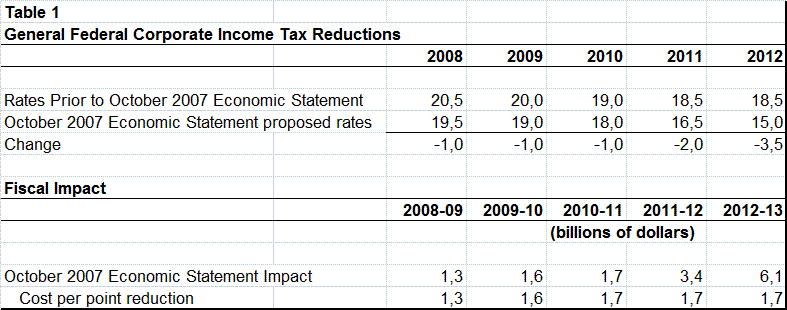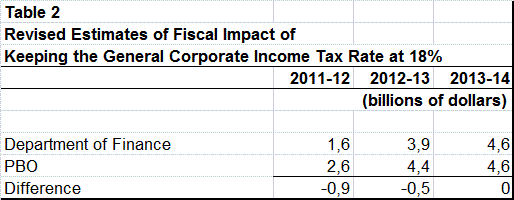Is the Liberal Platform Affordable?
The Liberals, in their election platform, presented a “Sources of Funds” table, itemizing the revenue increasing and spending reduction measures that they would implement to fund their proposed initiatives[1]. The revenue savings of one of the measures – the restoration of the corporate income tax rate to its 2010 level of 18% - has been questioned as being too high. But is it? In our opinion, the estimates used in the Liberal platform are reasonable. Moreover the Liberal platform includes a $6 billion reserve over 2 years to guard against forecast errors.
In the October 2007 Economic Statement, the Government proposed to advance and accelerate the corporate income tax rate reductions by one-point from 2008 to 2010, by two-points in 2011, and by 3.5-points thereafter. By 2012, the proposed rate would be 15% rather than 18.5 (see Table 1). In 2007, the fiscal impact of the proposed reductions in the corporate tax rate was estimated by Finance at $1.3 billion in 2008-09, rising to $6.1 billion in 2012-13. This information indicates that a reduction of 3.5 points in the corporate tax rate in 2012 would lead to a loss of $6.1 billion in federal corporate tax revenues. In other words, each point reduction in the corporate tax rate would result in a reduction of around $1.7 billion (when fully in place) in federal corporate tax revenues. Using these estimates suggests that keeping the corporate tax rate at 18% in 2012 would result in incremental revenues of about $5.2 - $5.4 billion in 2012-13.

In subsequent budgets and economic updates, and in various reports to Canadians on the Government’s Economic Action Plan, the Government provided no new impact estimates of the corporate tax rate reductions. In fact, the 2007 estimates were used extensively in presenting the fiscal impacts of all the various tax initiatives afforded to the business sector. Requests to the Department of Finance for “rules of thumb” on the impact on various tax changes were denied, as they were classified as “Cabinet Confidence”. This was particularly odd since these “rules of thumb” had been presented in budgets and related documents by previous governments and there was no credible reason for the government not to release them.
On October 24, 2010, the Minister of Finance’s Office released revised estimates to the Canadian Press in response to reports that the Liberals were planning to freeze the general corporate income tax at 18%. Subsequently, on October 28, 2010, Finance provided the House of Commons Standing Committee of Finance with revised estimates. The Government, however, never released these estimates publicly. In commenting on the information provided by the Government to the House of Commons on the costs of the fighter jets, the proposed crime legislation and the projections of corporate profits, the Parliamentary Budget Office (PBO) did provide an assessment of these estimates[2] in their report to the Committee.
The Department of Finance’s current estimates of the fiscal impact of holding the corporate rate at 18% and the PBO’s estimates are shown in Table 2.

Finance has revised the fiscal cost of the reduction in the general corporate income tax rate from 18% to 15 per cent to $3.9 billion in 2012-13 from their original estimate of about $5.2 to $5.4 billion. This new calculation now implies that a 1- point change in the corporate tax rate would change corporate tax revenues by only $1.3 billion, rather than the original estimate of $1.7 billion. The reason for the lower estimate is the impact of the recession on corporate profits. Corporate profits were about $50 billion lower (authors’ estimates) in the October 2010 Update than forecast in the October 2007 Update. This resulted in lower corporate income tax revenues of about $7 billion.
But how credible is this lower estimate for 2012-13? The PBO claims that Finance’s cost of the planned corporate income tax rate reduction is underestimated by $0.5 billion in 2012-13 (see Table 2). Finance’s estimate for 2012-13 appears suspect, considering the incremental increase in cost estimated for 2013-14, which is not supported by their projected increase in corporate profits.
Most importantly, the most recent Finance estimates were based on the October 2010 Update economic projections. In the March 2011 Budget, Finance revised up their projections for corporate income tax revenues, given the improved outlook for corporate profits. In addition, since the March 2011 Budget, energy prices have increased significantly in reaction to geo-political developments as have commodity prices in response to growing world demand. If oil prices continue to stay above the level assumed in the March 2011 Budget, and commodity prices continue to rise then corporate profits will be higher and the revenue savings resulting from keeping the rate at 18% could actually be higher than in the Liberal platform.
Although others have commented on the savings in the Liberal platform, to the best of our knowledge, only the Canadian Manufacturers and Exporters Association has officially published their own estimates. They estimate the impact of the corporate tax rate reduction from 18% to 15% in 2012 at $6.2 billion[3], in line with Finance’s first estimate but considerably higher than their latest estimate. .
In our opinion, the estimate of $5.2 billion for year 2 in the Liberal platform, is reasonable as is the cumulative total of $8.3 billion for 2 years. Some critics have argued that changes to tax rates have impacts on behavior that will reduce the first round direct cost estimates. This may be true, as behavior may change, but it is simply not possible to estimate with any accuracy on what those impacts would be. This issue has been discussed for years in international meetings of budget experts and to date no country allows for second round affects in budget planning and policy discussion. As a general principle, it is important to accept the simple reality that when it comes to any budget number - revenues or expenses - the range of uncertainty is fairly large. It is hard to get the first round affects reasonably right, let alone to include second round affects. Nevertheless, it is reasonable to assume that the risks associated with a 2-year projection of savings from corporate tax rate changes is likely to be considerably less than the risks associated with a 5-year projection that assumes the deficit will be eliminated in 2015-16.
To its credit, the Liberal platform recognizes this uncertainty and proposes to double the Contingency Reserve to $3 billion annually. This prudence reserve provides a $6 billion buffer over two years against adjustments to the costing estimates, twice as large as in the Government’s March 2011 budget.
The Government’s 2010 estimate of the impact of changes to the corporate tax rate is questionable and is already out-of-date as it is not based on the March 2011 Budget economic assumptions and fiscal projections. It comes late in the game. Despite changes to corporate profits, they stood by their original estimates until after the October 2010 Update. These new estimates were not included in the October 2010 Update, nor in the March 2011 Budget. As we have argued in the past, much more budget transparency is needed in order to properly assess the Government’s economic and fiscal projections.
[1] “Your Family. Your Future. Your Canada.” Page 92 Liberal Party of Canada
[2] “Fiscal Transparency: Parliament and the Expenditure Management System Analysis of Government Responses to a Motion of the House of Commons Standing Committee on Finance” February 25, 2011 Office of the Parliamentary Budget Officer.
[3] “The Economic Impact of Corporate Tax Rate Reductions” January 2011 Canadian Manufacturers & Exporters


Add new comment